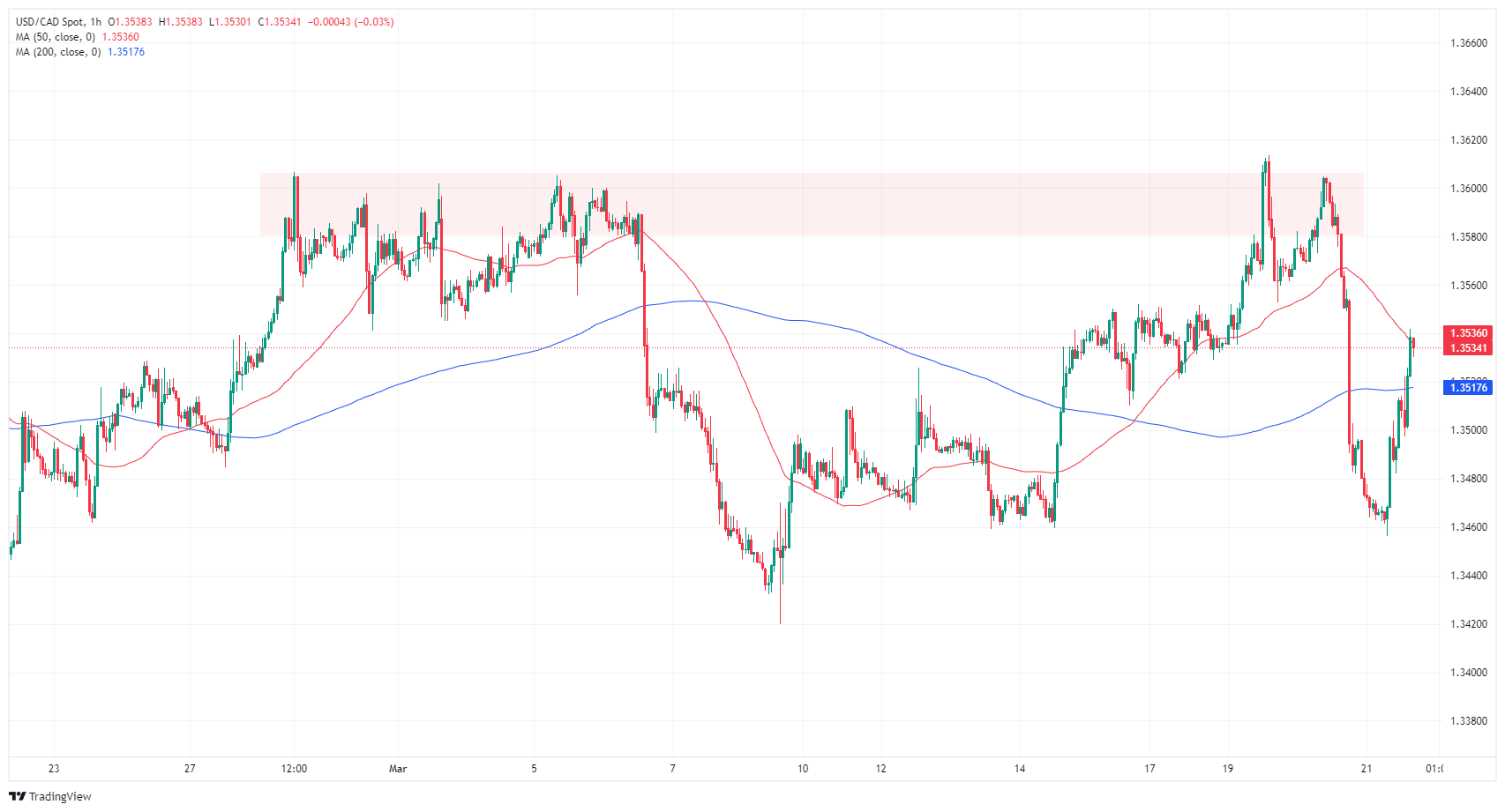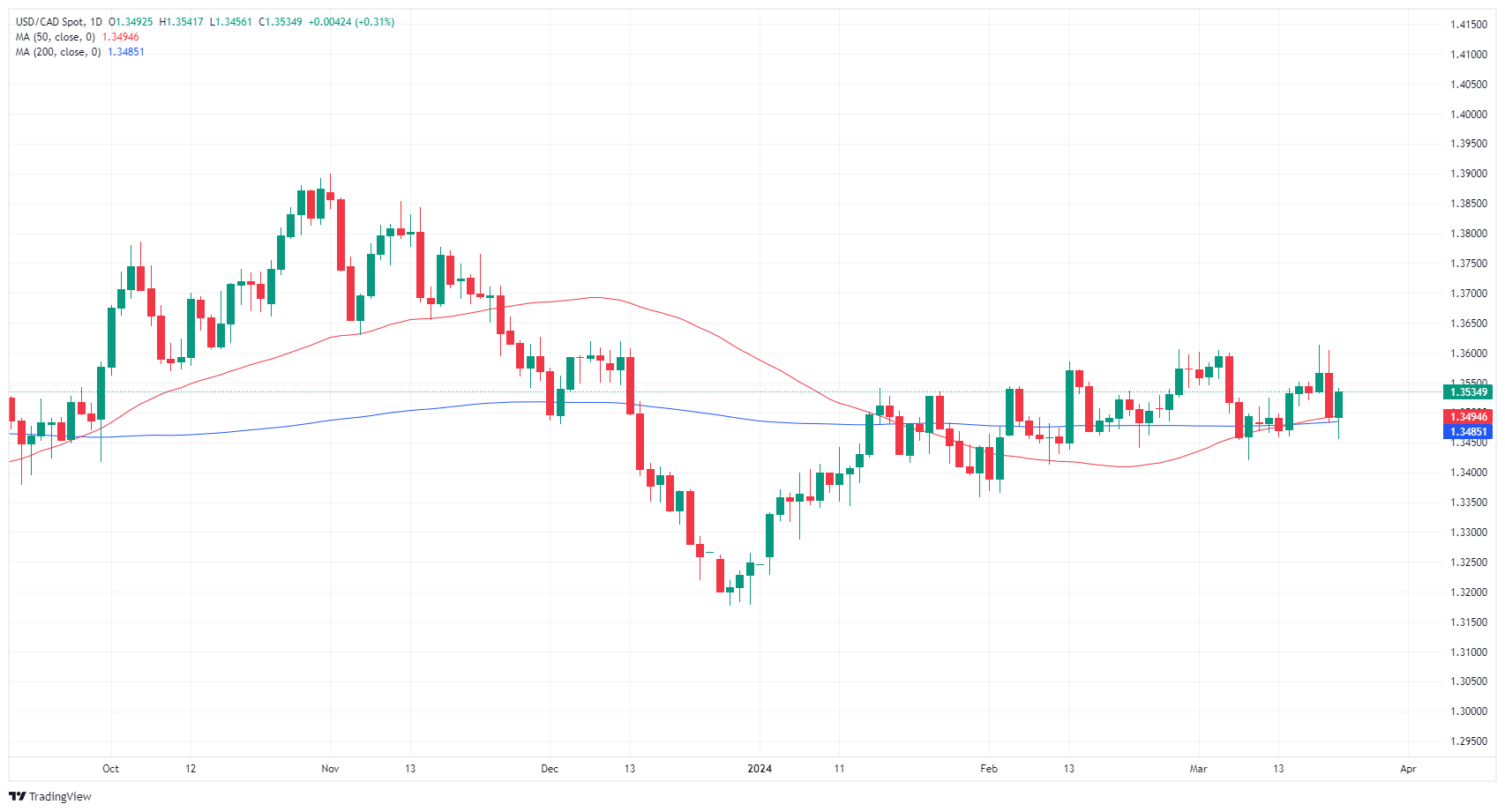- The Canadian dollar rises, but the USD rises faster.
- Canadian retail sales will be released on Friday.
- On Thursday, US PMIs delivered mixed results.
The Canadian Dollar (CAD) rose on Thursday, against most major currencies, but the US Dollar (USD) rose faster. Investors are reducing selling of the Dollar following the Fed's mid-week hike, which is boosting the Dollar overall.
Canada will return to the economic calendar with significant data on Friday. January retail sales are expected to fall about half a percentage point, after rising almost a percentage point in December.
Daily summary of market movements: Dollar dominates thanks to US data
- US Global Purchasing Managers' Index (PMI) figures were split on Thursday.
- The US Manufacturing PMI for March rose to 52.5 points from 52.2 previously, easily beating the forecast drop to 51.7 points.
- The March services PMI fell more than expected, falling to 51.7 from 52.3 the previous month, beating the forecast of 52.0.
- Initial US jobless claims fell to 210,000 in the week ended March 15, below the expected increase to 215,000 from 212,000 the previous week (revised up from 209,000).
- Scotiabank analysts have noted that April is typically the month in which the Canadian dollar performs best against the dollar.
Current rate of the Canadian dollar
The following table shows the percentage change of the Canadian Dollar (CAD) against the currencies listed today. The Canadian Dollar was the weakest currency against the US Dollar.
| USD | EUR | GBP | CAD | AUD | JPY | NZD | CHF | |
| USD | 0.71% | 1.03% | 0.45% | 0.39% | 0.61% | 0.71% | 1.50% | |
| EUR | -0.72% | 0.32% | -0.26% | -0.33% | -0.12% | 0.01% | 0.79% | |
| GBP | -1.05% | -0.33% | -0.59% | -0.63% | -0.45% | -0.32% | 0.46% | |
| CAD | -0.47% | 0.26% | 0.59% | -0.05% | 0.13% | 0.26% | 1.04% | |
| AUD | -0.40% | 0.32% | 0.64% | 0.06% | 0.19% | 0.33% | 1.10% | |
| JPY | -0.58% | 0.13% | 0.45% | -0.16% | -0.19% | 0.14% | 0.91% | |
| NZD | -0.71% | 0.00% | 0.32% | -0.26% | -0.33% | -0.10% | 0.80% | |
| CHF | -1.51% | -0.79% | -0.47% | -1.06% | -1.12% | -0.90% | -0.80% |
The heat map shows the percentage changes of the major currencies against each other. The base currency is chosen in the left column, while the quote currency is chosen in the top row. For example, if you choose the euro in the left column and scroll down the horizontal line to the Japanese yen, the percentage change in the box will represent EUR (base)/JPY (quote).
Technical Analysis: Dollar Rebounds, Bulls Outperform CAD
The Canadian dollar (CAD) advances on Thursday, gaining ground against almost all of its major currencies, despite falling around four tenths against the US dollar. However, the CAD remains stable against the Australian Dollar (AUD), the other best performing currency of the day.
USD/CAD is on the rise in trading on Thursday, with the bottom-to-top bullish momentum clipped by about 0.6%. The pair bounced from the 1.3460 area, reclaiming the well-known 1.3500 area in intraday trading.
Thursday's recovery marks a technical rejection of the 200-day SMA at 1.3485. In the short term, USD/CAD will remain range-bound.
USD/CAD Hourly Chart
USD/CAD Daily Chart
Frequently Asked Questions about the Canadian Dollar
What factors determine the price of the Canadian dollar?
The key factors that determine the price of the Canadian dollar (CAD) are the level of interest rates set by the Bank of Canada (BoC), the price of oil, Canada's main export product, the health of its economy, inflation and the trade balance, which is the difference between the value of Canadian exports and its imports. Other factors are market confidence, that is, whether investors bet on riskier assets (risk-on) or look for safe assets (risk-off), with the risk-on being positive for the CAD. As its largest trading partner, the health of the US economy is also a key factor influencing the Canadian dollar.
How do Bank of Canada decisions affect the Canadian dollar?
The Bank of Canada (BoC) exerts significant influence over the Canadian Dollar by setting the level of interest rates that banks can lend to each other. This influences the level of interest rates for everyone. The BoC's main objective is to keep inflation between 1% and 3% by adjusting interest rates up or down. Relatively high interest rates are usually positive for the CAD. The Bank of Canada can also use quantitative easing and tightening to influence credit conditions, with the former being negative for the CAD and the latter being positive for the CAD.
How does the price of oil affect the Canadian dollar?
The price of oil is a key factor influencing the value of the Canadian Dollar. Oil is Canada's largest export, so the price of oil tends to have an immediate impact on the value of the CAD. Generally, if the price of oil rises, the CAD also rises, as aggregate demand for the currency increases. The opposite occurs if the price of oil falls. Higher oil prices also tend to lead to a higher probability of a positive trade balance, which also supports the CAD.
How does inflation data influence the value of the Canadian Dollar?
Although inflation has traditionally always been considered a negative factor for a currency, as it reduces the value of money, the opposite has actually happened in modern times, with the relaxation of cross-border capital controls. Higher inflation often leads central banks to raise interest rates, attracting more capital inflows from global investors looking for a lucrative place to store their money. This increases the demand for the local currency, which in the case of Canada is the Canadian Dollar.
How does economic data influence the value of the Canadian dollar?
The published macroeconomic data measures the health of the economy and may have an impact on the Canadian dollar. Indicators such as GDP, manufacturing and services PMIs, employment and consumer confidence surveys can influence the direction of the CAD. A strong economy is good for the Canadian dollar. Not only does it attract more foreign investment, but it may encourage the Bank of Canada to raise interest rates, resulting in a stronger currency. However, if economic data is weak, the CAD is likely to fall.
Source: Fx Street
I am Joshua Winder, a senior-level journalist and editor at World Stock Market. I specialize in covering news related to the stock market and economic trends. With more than 8 years of experience in this field, I have become an expert in financial reporting.







